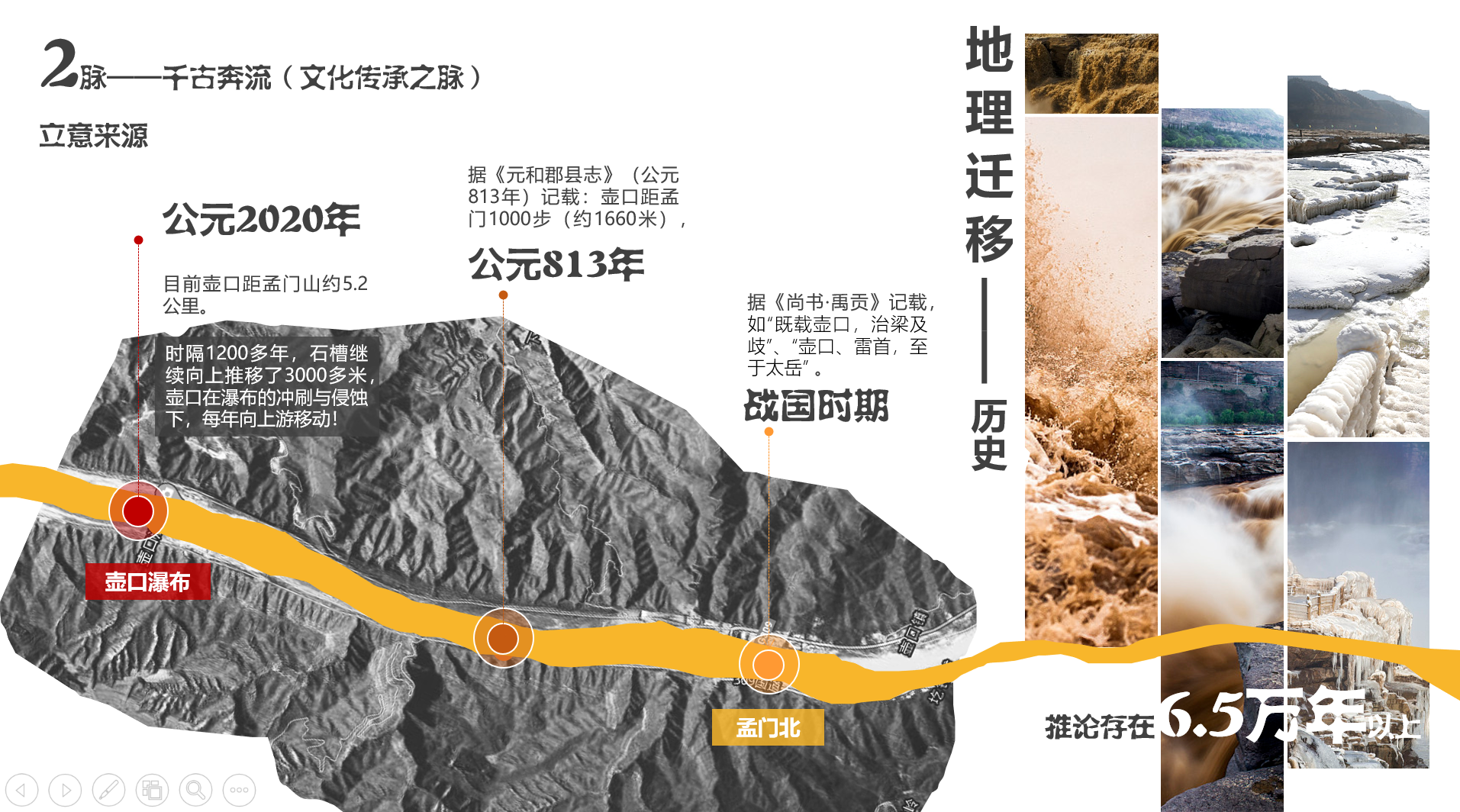A Thousand Year of Running Streams in Hukou
- History and Culture
- Source:HUKOU
- Browse volume:
- Release time:2021/10/27
(1) In 1753 AD, the waterfall was five thousand meters away from Mengmen.
Work: Yichuan County Record; Period: The 18th year of the Qianlong era of the Qing Dynasty (1753). Before liberation, the earliest of the three county magazines of Yichuan County, Wu Bing, the compiler of the "Yichuan County Record" of 1753, pointed out that the Yellow River Hukou Waterfall "flows wide upstream, and at this point it gathers into a trough, like the mouth of a pot, hence the name". It is also said that Mengmen "belongs to Pingzoli, 100 miles northeast of the county in the Yellow River, and can not be lost even if the water rises to the sky." His article "Hukou Kao" corrects some of the inaccuracies in the previous literature, and is an important reference in the study of Hukou.
(2) In 813 AD, the waterfall was a thousand paces away from Mengmen.
Work: Yuanhe County Record; Author: Li Jifu; Period: 8th year of Yuanhe; Type: Chinese geography monographs of the Tang Dynasty also describe the Hukou, calling it a stone trough. One says, "There is a mountain in the river, cut into it like a trough, and the stream is suspended for more than seventy feet." Another says that "the rock trough is 1,000 paces long and 30 paces wide", which is clearly different from what Li Daoyuan said, indicating that the Hukou Falls have been pushed upstream. The Yuanhe County Record was written in 813, the eighth year of the Tang Emperor Xianzong's reign, 286 years after the death of the Northern Wei Emperor Xiaoming in 527. This means that during the 286 years after Daoyuan, the Hukou Waterfall was pushed upstream a thousand paces from Mengmen, creating a deep trough about a thousand paces long and 30 paces wide in the riverbed, which has now moved up to the vicinity of Longwangchan, about 5 kilometres from Mengmen, known as the Shili Dragon Trough. The above is the history of the evolution of the Hukou over the past 1500 years.
(3) In 200 BC, the waterfall was at the location of Mengmen.
Work: Shanhaijing. Author: Unknown; Period: Pre-Qin; Type: The oldest of the mythological books. The name "Mengmen Mountain" was first mentioned in the "Shanhaijing", a work written between the Zhou and Qin dynasties, in which it is written that "another 320 miles to the south-east is called Mengmen Mountain, on which there is much pale jade, under which there is much yellow chalk and many nephrite stones".
(4) In the Northern Wei period, the book states that the waterfall was at Mengmen during the Warring States Period.
Work: Commetary to the Water Classic. Author: Li Daoyuan. Period: Late Northern Wei period. Type: A masterpiece of ancient Chinese geography. An insightful description of Mengmen and the waterfall: "Huainanzi" says: "Before the Dragon Gate was opened, before Lvliang was cut, the river came out above Mengmen, with a great overflow and reverse flow, without hills, and high mounds extinguished, and was called the flood, which Dayu dredged and called Mengmen. Therefore, the "Mu Tianzi Biography" said: north of the boarding, Mengmen nine stirrups of the river, Mengmen, that is, the mouth above the Dragon Gate, also, the actual Yellow River is a huge perfume, and the name of Mengjin carry on. This stone by the beginning of the Yu chisel, the river in the wash wide, sandwich bank Chong deep, the boulder in danger, if falling and leaning. The ancient people say that the water is not a stone chisel and can enter the stone, believe it. The water flows in a balanced manner, and the air floats in the clouds, so that those who go to and fro to see the river are often like fogs and dews that stain people and make their souls throb. The water is still crashing waves, hanging streams of thousands of feet, the most furious flood, drum mountain if the tentative, the wave of decadence, until the lower mouth, know Shenzi down the Dragon Gate flow floating bamboo, not a team of chasing also." The waterfall is located at Mengmen, but not at the mouth of the Yellow River.
(5) During the Warring States Period, the name "Hukou" was given to the area.
Work: Shang Shu·Yu Gong; Author: A native of the state of Wei during the Warring States Period, who gave his name to Dayu; Type: The first Chinese work on regional geography. The name "Hukou" is first found in Shang Shu·Yu Gong (The Book of Yu), where it is used in the Warring States Period, for example, in the phrases "both the Hukou and the Liang and the Divergent" and "the Hukou and the Leishou, up to the Taiyue "All of these are related to the route and strategy of Dayu's water treatment. Here Hukou is mentioned without mentioning the waterfall.


